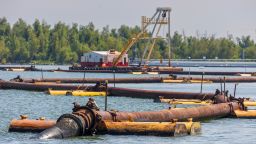Water barges and salt-filtering reverse osmosis units will not be enough to prevent saltwater from contaminating New Orleans’ largest water facility, officials said at city council meeting on Wednesday. Instead, a pipeline will be needed to deliver freshwater from upstream — not just for New Orleans, but likely for neighboring Jefferson Parish, too.
It would be a significant and pricey escalation in the region’s response to the saltwater wedge inching its way up the Mississippi River and contaminating drinking water for thousands of people.
“Barring the rain that’s probably not going to happen … the tactic or strategy we’re taking right now is drawing water further upriver,” Collin Arnold, director of homeland security and emergency preparedness for the city of New Orleans, told New Orleans City Council members.
Read more: Why is saltwater threatening New Orleans? Here’s what to know
Downstream on the Mississippi, Plaquemines Parish acquired reverse osmosis units to filter saltwater at all five of its water treatment plants, parish president Keith Hinkley told CNN on Tuesday. Hinkley believes the parish will have three online and cleaning water by next week. Two-thousand Plaquemines residents were the first to be affected by the saltwater wedge in mid-June.
But New Orleans’ Carrollton water treatment facility alone produces 135 million gallons per day for the east bank of Orleans Parish, according to the New Orleans Sewerage and Water Board website – an amount officials said is too large to cover with reverse osmosis and water barging.
Unsafe-to-drink saltwater is forecast by the US Army Corps of Engineers to reach New Orleans’ smaller Algiers water intake around October 22, and the Carrollton intake by October 28.
Arnold said the estimated cost to build a pipeline upriver could be between $100 million and $250 million. He said they hope to be reimbursed by the federal government for part of that cost.
He also noted the underwater sill, which the US Army Corps of Engineers began extending this week, can only buy so much time before the saltwater wedge reaches larger populations. “Every day we’re not building pipe is a lost day in that regard,” he said.
President Joe Biden on Wednesday approved an emergency declaration request from Louisiana Gov. John Bel Edwards for four parishes: Plaquemines, St. Bernard, Jefferson and Orleans.
New Orleans Sewerage and Water Board officials indicated that they’ve exhausted other avenues to mitigate the issue and have homed in on a few options, including the pipeline. They did not yet have an estimate for when work could begin on such a pipeline.
“I’m saying this is a regional effort — state, local and federal level — because the more we look into it, the magnitude of the solutions is quite expensive,” said Ron Spooner, interim general superintendent of the water board. “We just don’t want to downplay that. This is a very expensive proposition.”
Jefferson Parish officials also said Wednesday that reverse osmosis units and water barging will not be enough for their population and water needs. Parish officials said they were focusing on making sure bottled water is readily available and investigating “engineering” solutions to the problem.
“Many of these solutions are just not available to us in Jefferson Parish,” parish president Cynthia Lee Sheng said at a Wednesday council meeting. “We produce 70 million gallons (of water) a day, so if an osmosis machine is only able to produce 320,000 gallons a day, these are not solutions that are available to us.”
Jefferson is a sprawling parish that extends from west of New Orleans to Grand Isle on the Gulf of Mexico with a population of more than 430,000 that relies on its water system.
Sheng said the city of Gretna could be an exception to this because of its smaller size and dedicated water treatment plant, which outputs 4 million gallons of water a day to around 17,000 people. The parish has requested two reverse osmosis units, according to Edwards’ federal emergency request.
“Let’s just look at every creative way possible engineering-wise to minimize these impacts,” Sheng said. “We’re not really at that stage now, but we’re getting close, so stay tuned for us. We are looking at every way, exploring every possibility to minimize the impacts for us. Because really this does affect all of us in every single building, so we understand the challenges that we have. And trust me, no stone is being unturned with this team.”
CNN’s Ella Nilsen contributed to this report.





